Bellús Dam Administration Center
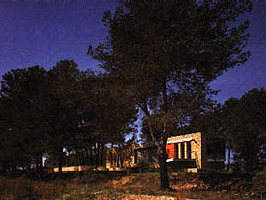
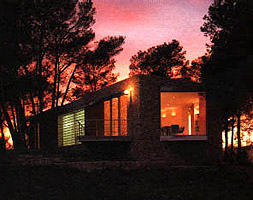
Arquitectos/Architects:
Antonio Marí y
Vicente Marí.
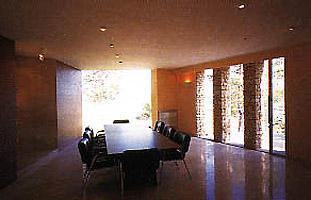
| Casa
Administración de la presa de Bellús Bellús Dam Administration Center |
|||
 |
 |
|
 |
| La Presa
de Bellús construida en el río Albaida y la formación del embalse para laminar sus
avenidas, generaron la necesidad de ejecutar obras e instalaciones que implicaban a
diversas especialidades profesionales. La laminación de avenidas en el Embalse de Bellús debe coordinarse en tiempo real con las actuaciones en otros embalses de la misma cuenca. Para ello es necesario disponer de una edificación que contenga el archivo de la Presa, donde se reciban los datos hidráulicos e hidrológicos de un suceso en tiempo real, donde el equipo responsable pueda analizar la información y tomar decisiones, desde donde se pueda transmitir al centro operativo en situaciones tanto normales como de alerta o emergencias, las señales del Sistema Automático de Información Hidrológica (S.A.I.H.) y del Sistema Automático de Información de Calidad del Agua (S.A.I.C.A.). Para ubicar la referida edificación - la Casa Administración -, se había reservado el único montículo arbolado existente en las proximidades del estribo izquierdo de la presa. Dicho montículo, visible desde todo el entorno, incluso desde las poblaciones cercanas, ofrecía una inmejorable situación, pero su valor paisajístico sugería una cuidada intervención que integrara en el paisaje las obras que sobre él se ejecutaran. Para el diseño de la "Casa Administración" se consideró procedente la contratación de un equipo de arquitectos que, en el marco de la Asistencia Técnica a la Dirección de Obra, desarrollaran el proyecto que satisficiera las necesidades funcionales ya aludidas y encajara en el terreno, sin alterar el arbolado existente, un edificio mimético con su entorno. Se sitúa la edificación sobre una loma aterrezada poblada por bosque de pinos, colindante al estribo izquierdo de la presa, con acceso rodado y peatonal mediante vial que parte cercano al mencionado estribo y que, ganando altura, conforma una plataforma de aparcamiento al servicio del helipuerto y continúa discurriendo paralelo a los aterrazamientos hasta alcanzar la edificación situada dentro del bosque, paralela a los aterrazamientos formados por ribazos de mampostería en seco; por lo que se ha pretendido con su diseño y con la elección de su ubicación, integrada al máximo en su entorno, reduciendo el posible impacto visual producido por su construcción. El programa de necesidades responde a un edificio administrativo con despachos, sala de juntas y un pequeño archivo. Se ha tenido en cuenta así mismo la posibilidad de poder acoger a personal de guardia que tuviera que pernoctar en él, para lo que se dispone de un pequeño dormitorio y sus correspondientes dotaciones de servicios. El edificio se diseña como un contenedor prismático dentro del cual se desarrolla el programa previsto. La disposición de huecos y sus proporciones intentan alejar al máximo su imagen de la de un edifico domestico, buscando crear un pieza abstracta que, dejada caer dentro del bosque, produzca el menor impacto posible. Se plantea interiormente como un edificio de planta libre capaz de soportar futuros cambios de distribución, según necesidades futuras, y que volará a través de un gran ventanal con vistas, girado para alinearlo con el eje de la presa, el objeto de ésta construcción, que no es otro que servir de apoyo. |
The
Bellús Dam, built in the Albaída river, and the formation of the reservoir to control
the water flow, generated the necessity of carrying out works and installations that
required several different professional specialisations. The control of the water flow in the Bellús dam must be coordinated in real time with operations on other dams in the same river basin. In order for this to happen it is necessary to have a building which constains a record office of the dam where the hydraulic and hidrographic information of an event in real time can be received, where the personnal responsible can analyse the information and take appropiate decisions, and where communication with the centre of operations can be established both in normal and emergency situations via the signals of the Automatic System of Hidrological information (S.A.I.H.) and the water quality informations (S.A.I.C.A.) For the location of the Centre, the only tree-covered mound in the proximity of the left-hand side of the dam was chosen. This mound, visible from the entire surrounding area including the nearby villages. offered the best possible location, but its landscape value made necesary a careful intervention that would integrate the construction work into the landscape upon which it was carried out. In the design of the Administrative Centre, it was considered necessary a team of architects who would develop the project in line with the functional and afforementioned necessities witin the framework of the Technical Assistance to the Construction Management. Also of importance was a design that would fit in with the existing tree formation; a construction in harmony with its surroundings. This building is sited on a terraced mound covered in pine woods, adjacent to the left-hand side of the dam with road and pedestrian access provided by a road that leads off the main route near the dam and which, gaining height, forms into a landing pad for the heliport and continues parallel with the stone mounds until it reaches the building inside the wood parallel to mounds formed by steep dry-stone slopes, which has facilitated through its design and location the maximum integration into its surroundings, thus reducing possible undesirable visual impact. The programme responds to the needs of an administrative building with offices, a board room and a small record office. The possibility of being able to accomodate night-shift personnnel who may have to sleep in the building has also been considered, and so a small dormitory together with the appropriate facilities has also been included. The shape of the building is a prismatic container within which the project is developed. The nature and proportions of the internal spaces are designed so as to make this construction as different as possible from a domestic building, looking to create an abstract form which being located in the wood prodeuces the minimum visual impact. The interior consists of free space adaptable to future changes in distribution, according to future necessities. It will contain a large window area with views aligned to the axis of the dam, the object of its construction, which is uniquely to serve as a support. |
|
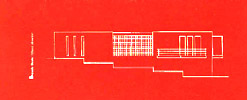 |
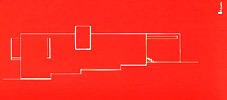 |
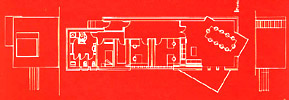 |
|
|
| Alzado oeste / Weast elevation | Alzado este / East elevation | Alzado sur / South elevation |